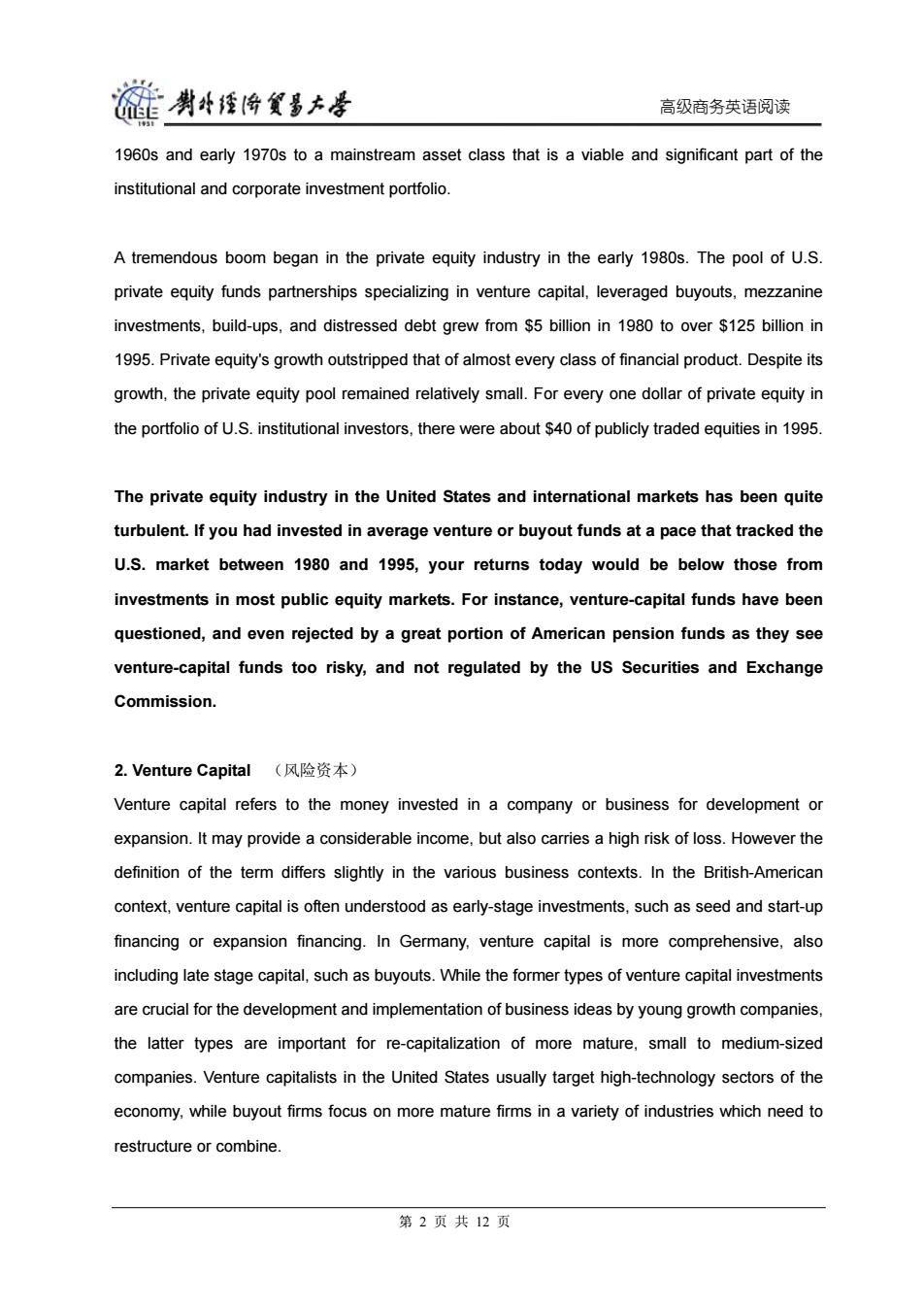正在加载图片...

剥牛煙将多大是 高级商务英语阅读 1960s and early 1970s to a mainstream asset class that is a viable and significant part of the institutional and corporate investment portfolio. A tremendous boom began in the private equity industry in the early 1980s.The pool of U.S. private equity funds partnerships specializing in venture capital,leveraged buyouts,mezzanine investments,build-ups,and distressed debt grew from $5 billion in 1980 to over $125 billion in 1995.Private equity's growth outstripped that of almost every class of financial product.Despite its growth,the private equity pool remained relatively small.For every one dollar of private equity in the portfolio of U.S.institutional investors,there were about $40 of publicly traded equities in 1995. The private equity industry in the United States and international markets has been quite turbulent.If you had invested in average venture or buyout funds at a pace that tracked the U.S.market between 1980 and 1995,your returns today would be below those from investments in most public equity markets.For instance,venture-capital funds have been questioned,and even rejected by a great portion of American pension funds as they see venture-capital funds too risky,and not regulated by the US Securities and Exchange Commission. 2.Venture Capital(风险资本) Venture capital refers to the money invested in a company or business for development or expansion.It may provide a considerable income,but also carries a high risk of loss.However the definition of the term differs slightly in the various business contexts.In the British-American context,venture capital is often understood as early-stage investments,such as seed and start-up financing or expansion financing.In Germany,venture capital is more comprehensive,also including late stage capital,such as buyouts.While the former types of venture capital investments are crucial for the development and implementation of business ideas by young growth companies, the latter types are important for re-capitalization of more mature,small to medium-sized companies.Venture capitalists in the United States usually target high-technology sectors of the economy,while buyout firms focus on more mature firms in a variety of industries which need to restructure or combine 第2页共12页高级商务英语阅读 1960s and early 1970s to a mainstream asset class that is a viable and significant part of the institutional and corporate investment portfolio. A tremendous boom began in the private equity industry in the early 1980s. The pool of U.S. private equity funds partnerships specializing in venture capital, leveraged buyouts, mezzanine investments, build-ups, and distressed debt grew from $5 billion in 1980 to over $125 billion in 1995. Private equity's growth outstripped that of almost every class of financial product. Despite its growth, the private equity pool remained relatively small. For every one dollar of private equity in the portfolio of U.S. institutional investors, there were about $40 of publicly traded equities in 1995. The private equity industry in the United States and international markets has been quite turbulent. If you had invested in average venture or buyout funds at a pace that tracked the U.S. market between 1980 and 1995, your returns today would be below those from investments in most public equity markets. For instance, venture-capital funds have been questioned, and even rejected by a great portion of American pension funds as they see venture-capital funds too risky, and not regulated by the US Securities and Exchange Commission. 2. Venture Capital (风险资本) Venture capital refers to the money invested in a company or business for development or expansion. It may provide a considerable income, but also carries a high risk of loss. However the definition of the term differs slightly in the various business contexts. In the British-American context, venture capital is often understood as early-stage investments, such as seed and start-up financing or expansion financing. In Germany, venture capital is more comprehensive, also including late stage capital, such as buyouts. While the former types of venture capital investments are crucial for the development and implementation of business ideas by young growth companies, the latter types are important for re-capitalization of more mature, small to medium-sized companies. Venture capitalists in the United States usually target high-technology sectors of the economy, while buyout firms focus on more mature firms in a variety of industries which need to restructure or combine. 第 2 页 共 12 页